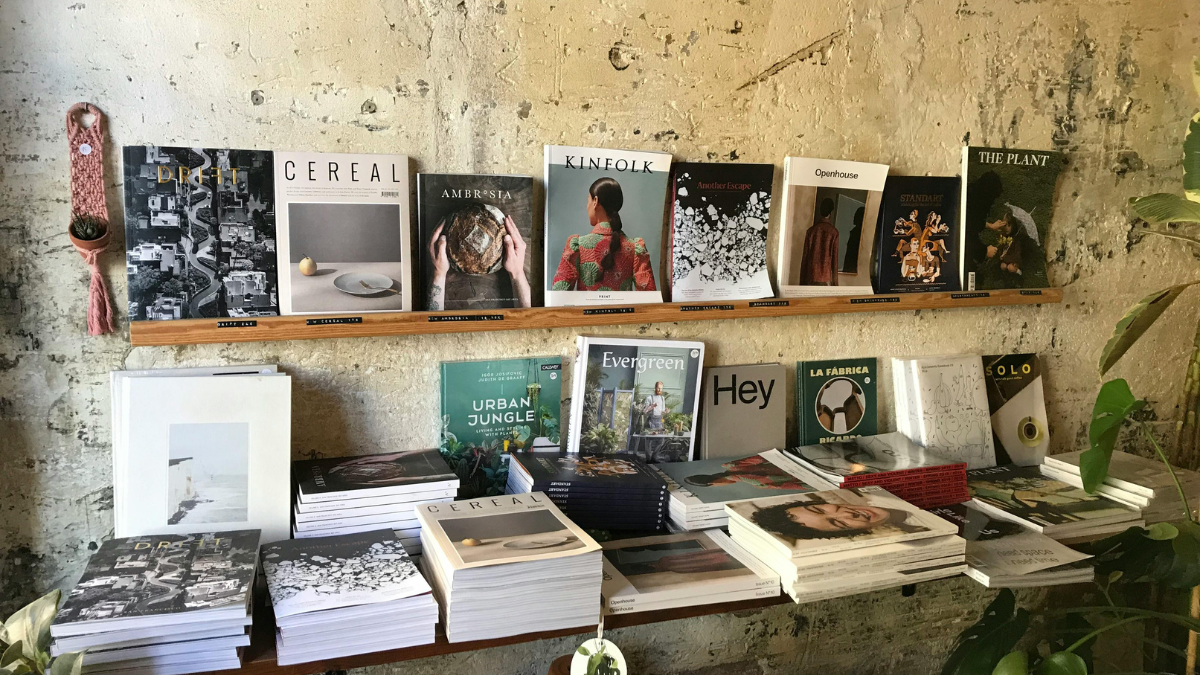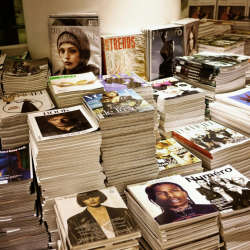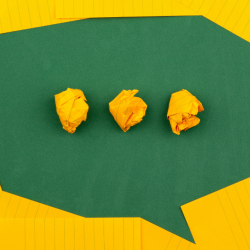Just like the printing press before it, the internet promised the global delivery and dissemination of information to improve public knowledge. And for a while this worked, until its incentive — to make things uniform, standardised, stuffed with facts — led it to gorge itself into incapacitation on a mukbang of SEO-driven content. Now, we live in fear of a dead internet — an online landscape devoid of creativity where content is generated by bots, for bots (take shrimp Jesus, for example), and where human touch is sparse. It’s for this reason that over the past few years, we’ve started to move offline, and why we’ve seen a growth in trends that emphasise finding community in nature, like cottagecore, tradwives, witchcraft, and neofolk.
As we shift offline, it isn’t just our minds and bodies we want to transplant into this physical realm. We’re invested in bringing worthwhile reading material with us. An oft-floated statistic originating from Enders Analysis says that 330 new print magazines were launched in 2022, and research from PAMCo suggests that print magazines are reaching up to 20.5 million UK adults per month. This is a market rife for tapping into — but only if brands are authentic (a green flag for Gen Z consumers), and reinforce the sense of community and connection that is being lost digitally.
A desire for interest curation

One key factor fuelling the return to physical magazines is a broader desire for ownership over tangible objects — seen in a boost in the sale of vinyls (growing roughly by 11.7% each year), and the continuing influence of BookTok on brick-and-mortar book sales. It seems Gen Z increasingly wish to accumulate and curate possessions that align with their personal interests and vibes, and find learning about the likes of others (even if not shared), enjoyable, as proven by the virality of niche collectors. It makes sense then that print magazines, especially those that delve into obscure or specific topics, become a natural choice for collection. They satisfy an urge to display and signpost our offline habits and personas, while also chiming with aesthetics popularized online. Titles like Weird Walk zine, a magazine covering everything from rural wanderings to dungeon synth, feel at home stacked in the kitsch, trinket-filled bedrooms we see plastered over TikTok.
Twoside also links the return of print to what has been coined ‘digital deluge’— a term for the overconsumption of meaningless content that we have little to no agency over. When algorithmically-informed scrolling overwhelmingly defines our internet experience, it can feel freeing to return to a system of personally picking and choosing what we want to read, watch or otherwise invest energy into. Gen Z’s tendency to see all media, regardless of esteem, as worthy of analysis (for better or worse), means this can be anything from serious news to benign gossip, and often, it is a mixture.
This personal system of content curation is best displayed in handmade and DIY items (something consumers love across the board — just look at Etsy, where active buyers increased last year to 97.3 million), especially reading material. For example, fanfic binding and selling, which has come under scrutiny recently, demonstrates a growing desire to boast physical copies of stories once confined to private fandoms, and associate ourselves with this publicly. Gen Z also enjoy designing and making their own magazines and mini zines as gifts, personal jokes or to update friends and family on their lives and lore — similar to TikTok’s PowerPoint trend.
Diving into nostalgia
While many newly launched print magazines are fresh titles, it would be a mistake to downplay the role of nostalgia in the medium’s overall popularity. Nostalgia continues to shape trends and aesthetic preferences on TikTok — with slideshows of old Flickr photos set to wistful music and analysis of skeuomorphic 2000s web aesthetics like ‘frutiger aero’ receiving heavy traction on the app. Our broader desire to remember and relive aspects of childhood is, according to Forbes, also behind a boom in physical media collection in other forms, specifically retro video games.
It follows that this would also have an influence on the print industry too, especially when individual magazines arrive alongside viral nostalgic trends — the relaunch of NME, for example, aligns with a long-awaited indie sleaze revival chiefly popularized by TikTok.
Magazines work as cultural touchstones that disrupt our present, able to transport us into past eras and vividly experience them as if we were there. By investing in print, we’re establishing checkpoints and time capsules that stop micro-trends and aesthetics in their tracks, creating a permanence that we long for in today’s rapid trend cycle, and cementing hypothesized trends in reality. There’s also an element of irony at play for many nostalgic magazine collectors. As Canvas8 explains, many consumers are drawn to collecting or engaging with bad or passe magazines from the aughts, whether these are gaudy Playboy editions or overly twee teen music mags. It might start as a self-aware mockery or bit, but the absurdity of Gen Z humour has lasting power and can turn anti-trends into accidental art, as anyone who is familiar with corecore will recognize.
Preserving high-quality journalism
The gradual amalgamation of traditional reporting into YouTube video essays of varying quality, encouraged by vigilante sleuthing that has its roots on Reddit, has also led to renewed concerns over plagiarism. Anyone can write online, (and anyone can rip this off), but a physical magazine is harder to infiltrate — once published, it is safe from covert edits and changes, and less susceptible to plagiarism overall. Readers know, or at least feel, that print mags are more legit and factually sound than information they’d find online in 2024, and writers feel as if their work is better protected and encased from prying opportunists.
Writers are also more likely to be fairly compensated for their work. For roughcast, a new print magazine that launched last year, a priority is paying freelancers promptly — something major digital publications regularly fail to do. With increasing layoffs across traditional media and outlets like Vice collapsing or pivoting to video, there’s also a growing fear that our decades-old marks online will become lost to time. The so-called digital footprints of our youth (that many of us were rather laughably told would haunt us forever), are disappearing, increasingly accessible only through emulators of old internet like the Wayback Machine. An article about something we love, whether it’s one we ourselves wrote or bookmarked for safekeeping, could be inaccessible in a few years time, but a well-cared for magazine exists forever. Responsibility for its upkeep lies in our hands, too, rather than those of unscrupulous media outlets.
Print brings the focus back to the individual — who can curate and keep whatever they’d like to last forever.
Featured image: Oleksandra / Pexels































